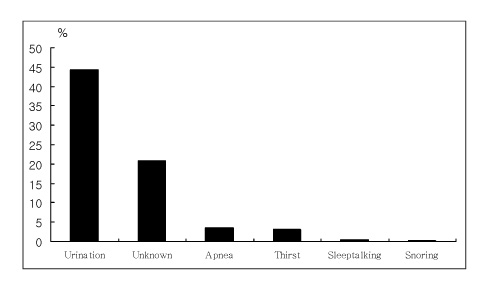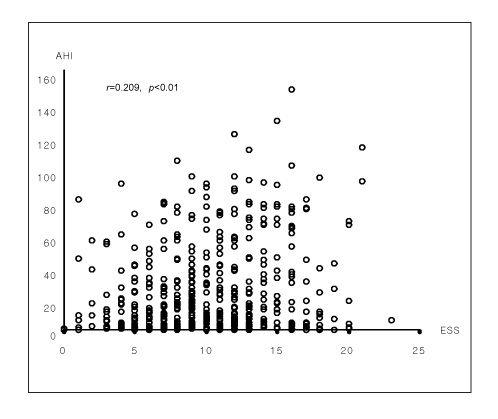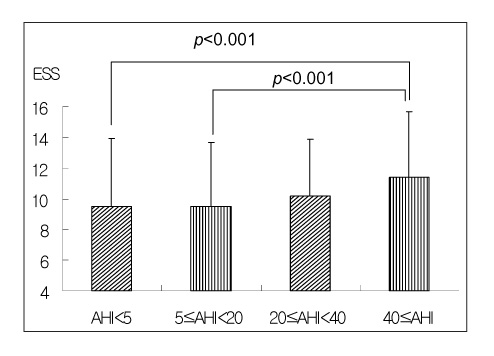Tuberc Respir Dis.
2006 Jan;60(1):76-82.
Analysis of Sleep Questionnaires of Patients who Performed Overnight Polysomnography at the University Hospital
- Affiliations
-
- 1Department of Internal Medicine, The Catholic University of Korea, College of Medicine, Seoul, Korea. hsmoon@catholic.ac.kr
- 2Department of Preventive Medicine, The Catholic University of Korea, College of Medicine, Seoul, Korea.
Abstract
-
BACKGROUND: The objective of this study was to understand sleep-related problems, and to determine whether the sleep questionnaires is a clinically useful method in patients who need polysomnography.
METHODS
Subjects were patients who performed polysomnography and who asked to answer a sleep questionnaires at the Sleep Disorders Clinic of St. Paul's Hospital, Catholic University of Korea. Baseline characteristics, past medical illness, behaviors during sleep-wake cycle, snoring, sleep-disordered breathing and symptoms of daytime sleepiness were analyzed to compare with data of polysomnography.
RESULTS
The study population included 1081 patients(849 men, 232 female), and their mean age was 44.2+/-12.8 years. Among these patients, 38.9% had an apnea-hypopnea index(AHI) < 5, 27.9% had 5 < or = AHI < 20, 13.2% had 20 < or = AHI < 40, and 20.0% had 40 < or = AHI. The main problems for visiting our clinic were snoring(91.7%), sleep apnea(74.5%), excessive daytime sleepiness(8.0%), insomnia(4.3%), bruxism(1.1%) and attention deficit(0.5%). The mean value of frequency of interruptions of sleep was 1.6 and the most common reason was urination(46.3%). Epworth Sleepiness Scale(ESS) had a weak correlation with AHI(r=0.209, p<0.01). When we performed analysis of sleep questionnaires, there were significant differences in the mean values of AHI according to the severity of symptoms including snoring, daytime sleepiness, taking a nap and arousal state after wake(p<0.05).
CONCLUSION
On the basis of statistical analysis of sleep questionnaires, the severity of subjective symptoms such as ESS, snoring, daytime sleepiness and arousal state after wake correlated with the AHI significantly. Therefore the sleep questionnaires can be useful instruments for prediction of the severity of sleep disorder, especially sleep-disordered breathing.
MeSH Terms
Figure
Reference
-
1. Henk B, Robert VW, Rene MK, Jan MB, Paul IM, Frans GA. Long-term results of uvulopalatopharyngoplasty for obstructive sleep apnea syndrome. Laryngoscope. 2000. 110:469–475.2. Wittles ES. Obesity and hormonal factors in sleep and sleep apnea. Med Clin North Am. 1985. 69:1265–1280.3. Brown IB, McClean PA, Boucher R, Zamel N, Hoffstein V. Changes in pharyngeal cross-sectional area with posture and application of continuous positive airway pressure in patients with obstructive sleep apnea. Am Rev Respir Dis. 1987. 136:628–632.4. Ronald DC, Christian G. Obstructive sleep apnea and related disorders. Neurol Clin. 1996. 14:583–609.5. Medelson WB. Use of the sleep laboratory in suspected sleep apnea syndrome: is one night enough? Cleve Clin J Med. 1994. 61:299–303.6. Rechtschaffen A, Kales A. A manual of standardized terminology, techniques and scoring system for sleep stages of human subjects. 1968. Los Angeles: Brain information service/brain research institude, University of California Los Angeles.7. Iber C, O'Brien C, Schulter J. Single-night studies in obstructive sleep apnea. Sleep. 1991. 14:383–385.8. Sleep-related breathing disorders in adults: recommendations for syndrome definition and measurement techniques in clinical research: The Report of an American Academy of Sleep Medicine Task Force. Sleep. 1999. 22:667–689.9. Akashiba T, Kawahara S, Akahoshi T, Omori C, Saito O, Majima T, et al. Relationship between quality of life and mood or depression in patients with severe obstructive sleep apnea syndrome. Chest. 2002. 122:861–865.10. American Thoracic Society/American Sleep Disorders Association. Statement on health outcomes research in sleep apnea. Am J Respir Crit Care Med. 1998. 157:335–341.11. Grunstein RR, Stenlof K, Hedner JA, Sjostrom L. Impact of self-reported sleep-breathing disturbances on psychosocial performance in the Swedish Obese Subjects(SOS) Study. Sleep. 1995. 18:635–643.12. Powell NB, Schechtman KB, Riley RW, Li K, Troell R, Guilleminault C. The road to danger: the comparative risks of driving while sleepy. Laryngoscope. 2001. 111:887–893.13. Derderian SS, Bridenbaugh RH, Rajagopal KR. Neuropsychologic symptoms in obstructive sleep apnea improve after treatment with nasal continuous positive airway pressure. Chest. 1988. 94:1023–1027.14. Bardwell WA, Berry CC, Ancoli-Israel S, Dimsdale JE. Psychological correlates of sleep apnea. J Psychosom Res. 1999. 47:583–596.15. Moon HS, Choi YM, Song JS, Park SH. The changes of plasma atrial natriuretic peptide concentrations during waking and sleep in patients with obstructive sleep apnea syndrome. Sleep Med Psychophysiol. 1995. 2:156–164.16. Steers WD, Suratt PM. Sleep apnoea as a cause of daytime and nocturnal enuresis. Lancet. 1997. 349:1604.17. Arai H, Furuta H, Kosaka K, Kaneda R, Koshino Y, Sano J, et al. Polysomnographic and urodynamic changes in a case of obstructive sleep apnea syndrome with enuresis. Psychiatry Clin Neurosci. 1999. 53:319–320.18. Guilleminault C, Lin CM, Goncalves MA, Ramos E. A prospective study of nocturia and the quality of life of elderly patients with obstructive sleep apnea or sleep onset insomnia. J Psychosom Res. 2004. 56:511–515.19. Basha S, Bialowas C, Ende K, Szeremeta W. Effectiv eness of adenotonsillectomy in the resolution of nocturnal enuresis secondary to obstructive sleep apnea. Laryngoscope. 2005. 115:1101–1103.20. Gottlieb DJ, Whitney CW, Bonekat WH, Iber C, James GD, Lebowitz M, et al. Relation of sleepiness to respiratory disturbance index: the Sleep Heart Health Study. Am J Respir Crit Care Med. 1999. 159:502–507.21. Weaver EM, Kapur V, Yueh B. Polysomnography vs self-reported measures in patients with sleep apnea. Arch Otolaryngol Head Neck Surg. 2004. 130:453–458.22. Moore P, Bardwell WA, Ancoli-Israel S, Dimsdale JE. Association between polysomnographic sleep measures and health-related quality of life in obstructive sleep apnea. J Sleep Res. 2001. 10:303–308.23. Lacasse Y, Bureau MP, Series F. A new standardised and self-administered quality of life questionnaire specific to obstructive sleep apnea. Thorax. 2004. 59:494–499.




